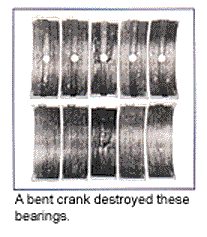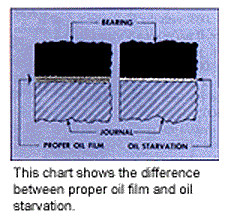Today’s engines typically have very tight tolerances everywhere and the crankshaft bearings are no exception. The truer the crank is in its alignment with the mainline and cylinder bore, the tighter the tolerances can be.
Bearings and mainline bores must be very precise because during operation the crankshaft is not actually straight: it is elastic. Think of a jump rope spinning around and you can begin to picture what a crankshaft is like under the pressure and forces of combustion.
Arguably, it’s the most important piece in the engine, because almost every moving part in the engine is in some way attached to the crankshaft. For engine builders this requires close attention to any crankshaft’s condition before returning it to service.
The relationship between the crankshaft and the engine bearings is a tight one – and thanks to increased advancements in technology, getting tighter every year. Engine builders are faced with the responsibility of machining the main and rod bearing journals to allow the bearings to fit tightly yet still allow an oil film. The crankshaft does not turn directly on the bearings but on the thin film of oil trapped between the surfaces. Should the crank journals get out of round, tapered or scored, the oil film will not form properly.
However, service on a crankshaft is no walk in the park. One engine builder we spoke to for this article said that it has become difficult to make a good profit on crankshaft work once its condition gets beyond a certain point. Companies that specialize in crankshaft reconditioning may be getting more work from engine builders these days because many are sending them out to be welded or repaired instead of doing it themselves.
There are several things that must be done in order to properly recondition a crankshaft such as removing all the galley plugs along with any gears that are attached. Then the crankshaft should be thoroughly cleaned and inspected for any damage to see how far out of specification it may be. There is much more to reconditioning a crank than this, of course, but the main point is you have to know what you have before you decide to reuse it or trash it.
According to our experts, it’s not always necessary to grind a crankshaft to bring it back to acceptable condition. However, journal roundness, surface finish, taper, diameter, residual magnetism and fillet radii must be checked and meet the manufacturer’s specifications.
Clearances
Clearance is a crutch for bad alignment, according to some experts. “If you have very ‘elegant’ true position on the main line, and the true position of the cylinder for the main journals and pin journals and the big end and little end of the rods and bore alignment are all ‘sweet,’ the less clearance you need,” says Don Sitter, Clevite Engine Parts.
For the average custom engine rebuilder, typical clearance is around .001″ per engine journal diameter, and for safety sake you should add .0005″ just to be safe. “If you’ve got a 2.200″ crankpin, then you’ll want between .0025″ – .003″ with the Plastigage for clearance. If you’ve got a 3″ main bearing, then you’re going to try to fit between .0034? – .0037″,” says Sitter. The rule of thumb is roughly .001? of clearance per inch of shaft diameter above .500″.
“The elegant true position may fit to 75 percent of this rule or less,” says Sitter. “You have to remember, your incentive for doing this is: what does the damage to the bearing? It’s not the crankpin or the main journal pounding on the bearing; it’s the pressure in the oil film that’s supporting that connecting rod on the pin and the main bearing journals in the saddle. The more clearance you have, the higher your oil film pressure becomes and the lower your film becomes at the same time.”
Polishing
The oil wedge that the crank rides on is only about .00005? thick when the engine is running. Tolerances like these necessitate a properly polished crankshaft. If there are any iron nodules or burrs sticking up from the surface of the journal, it doesn’t take much to abrade the bearing or drastically increase the chances of seizure.

“The process of crankshaft grinding and polishing is an art form,” says Sitter. There are some good polishing and micropolishing machines out there, but they must be used properly. Material, on the other hand, is very picky – it requires a scientific approach. The ferrite caps can’t poke through and can’t point in the wrong direction, opposed to the rotation.
Ferrite burrs create a directional sawtooth-like finish on the surface of the crank journal, typically the opposite direction the journal was ground or polished. It is critical to know which way the crank normally rotates so that it can be polished in such a way that the ferrite caps point in a favorable direction. A relatively flat and smooth surface finish is most desirable. There aren’t any nodules or ferrite caps to be concerned with on forged steel cranks, only cast cranks, so it is not necessary to grind in one direction and polish in the other.
No matter how good an artist you are, it is not always possible to reuse a crankshaft in some cases. Some crankshafts are either too far out to bring back to spec or the labor involved to do so is too costly. One rebuilder we spoke with said he doesn’t weld cranks anymore because he doesn’t make enough money doing them, and if a crank does need to be welded he sends it out to another shop that specializes in repairing them. This doesn’t mean, however, that he doesn’t do any crank work. He still grinds them and balances them and even straightens them.

If you do go the reconditioning route, it is very important to thoroughly inspect the crankshaft for any cracks because it may mean that crank cannot be reconditioned. One of the leading reasons rebuilders buy replacement crankshafts is that when they do a magnetic particle inspection (MPI) they find that it is cracked. The next biggest reason, according to manufacturers we spoke with is when rebuilders have to weld the crank because one journal is .040″ or .050″ out and it has to be built up.
According to one crankshaft manufacturer, many of his customers walk the fine line between reconditioning a crank and buying a new one. “If all the crank needs is a straight grind, you can do that and move on. But if you need to weld the crank at all, you may be better off buying a new crank. After all the time and labor are added together when you’re done welding it, the cost may actually be less to buy a new one. And after all that, you still have a welded crank,” he notes.
One of the more recent trends seen in crankshaft development is they are starting to make more cast cranks instead of forged. And the main reason for this, we’ve learned is because the OEMs went back to cast cranks. It’s less expensive for the manufacturers to make a cast crank than a forged one. John Deere was one of the first ones to do it, according to a leading supplier of replacement crankshafts.
“They have cast crankshafts with rolled fillets even on some of their larger engines such as the 8.1L. With the rolled fillets there’s no radius, it’s on the inside,” says a spokesperson. “Many rebuilders have gone to this type of crank. And if I send them a forged crank with a regular radius in it, then we have to explain that it’s just as good or better, but to some it’s not genuine John Deere if it doesn’t have a rolled fillet.”
Cranks with rolled fillets may reduce an engine builder’s ability to recondition it. The problem with rolled fillets is that you can only grind them to .010″, which takes a lot of the serviceability out of the crankshaft.”
Having a well-balanced crankshaft is another important element to properly reconditioning a crank. In a running engine, there are dynamic forces that exist, and a little bit of imbalance at low rpm becomes much more at higher and higher rpm. For example, at four inches from the crankshaft’s center axis and with 28 grams out of balance there’s 112 lbs of force on the crank at 4,000 rpm, which then increases to a whopping 448 lbs at 8,000 rpm.
Failures
Debris is our number one cause of failure, without a doubt,” says Federal-Mogul Corp.’s Jeff Richardson. “When people grind cranks or they clean a head, there’s always debris somewhere.”
Clevite’s Sitter also agrees that debris is a major cause of bearing failure. “I’d say at least half of all failures are debris-related,” says Sitter. Misassembly and misalignment are about equal as far as bearing failures go. Debris can get trapped between the journal and the bearing surface and cause all kinds of problems. Debris may abrade the surface and score a journal or wipe the oil film, which may lead to a bearing seizure.
Insufficient lubrication needs to be considered as another cause of failure, too. If you break down the oil wedge you’ll have metal-to-metal contact. It’ll destroy both the bearing surface and crankshaft surface.
With regard to bearing materials, the aftermarket has generally been forced to follow whatever the OEMs decide to do as far as bearing technology is concerned. However, the aftermarket has at least one thing on its side that the OEMs don’t – hindsight. Aftermarket bearing manufacturers can watch what the OEMs do and study their failures and successes to see what works best. Most late model engines are now designed to use aluminum bearings.
“The biggest reason that we’re finding for going to aluminum bearings is that it seems to be a better choice for late-model applications,” says Jeff Richardson, Federal-Mogul Corporation. “And even going back to some of the older applications, we’re finding that aluminum is just a better overall fit for light-duty replacement applications.”
Clevite also offers a few aluminum bearings for some of the more popular applications, mostly for production engine rebuilders. However, tri-metal bearings are still popular choices for heavy duty and performance applications.
“We still offer our tri-metal bearings, but the aluminum gives engine builders another option,” says Jeff Schaerer, Clevite. “One of the reasons we use aluminum is that it’s a harder material, so the aluminum silicon actually conditions the journal after it has been reground.”
Material
Aluminum bearings are not new technology. In fact, they have been around for a long time, but today’s materials are superior to yesterday’s aluminum bearings. “Our old corporate material on aluminum goes back into the ’60s,” explains Federal Mogul’s Richards. “A couple of years back we created the material we termed ‘A-500.’ This is what really pushed us over the edge to what was better.”
A-500, the material makeup of the lining material itself, is an aluminum-silicon lining. The silicon is what bearing manufacturers have determined make aluminum a preferred material for late-model bearing applications. The small particles of silicon, finely and evenly dispersed throughout the lining material, give it a better fatigue rating and better seizure resistance. And those small particles of silicon will actually polish the crank if you have any imperfections on the crank.
Another bearing manufacturer, King Engine Bearings, uses what is called ‘Alecular’ bearing material in which the alloy is made up of aluminum, copper, tin and several other elements. In addition, since it’s an alloy it can maintain its properties throughout its entire depth resulting in more consistent, reliable performance. King’s Alecular material can be used in high-load applications as well as street applications and has been able to withstand the stress and strain of blown, nitro-burning Top Fuel dragster engines that produce up to 5,000 hp. Also the Alecualar material has a melting/fatigue point that is over 1,100













